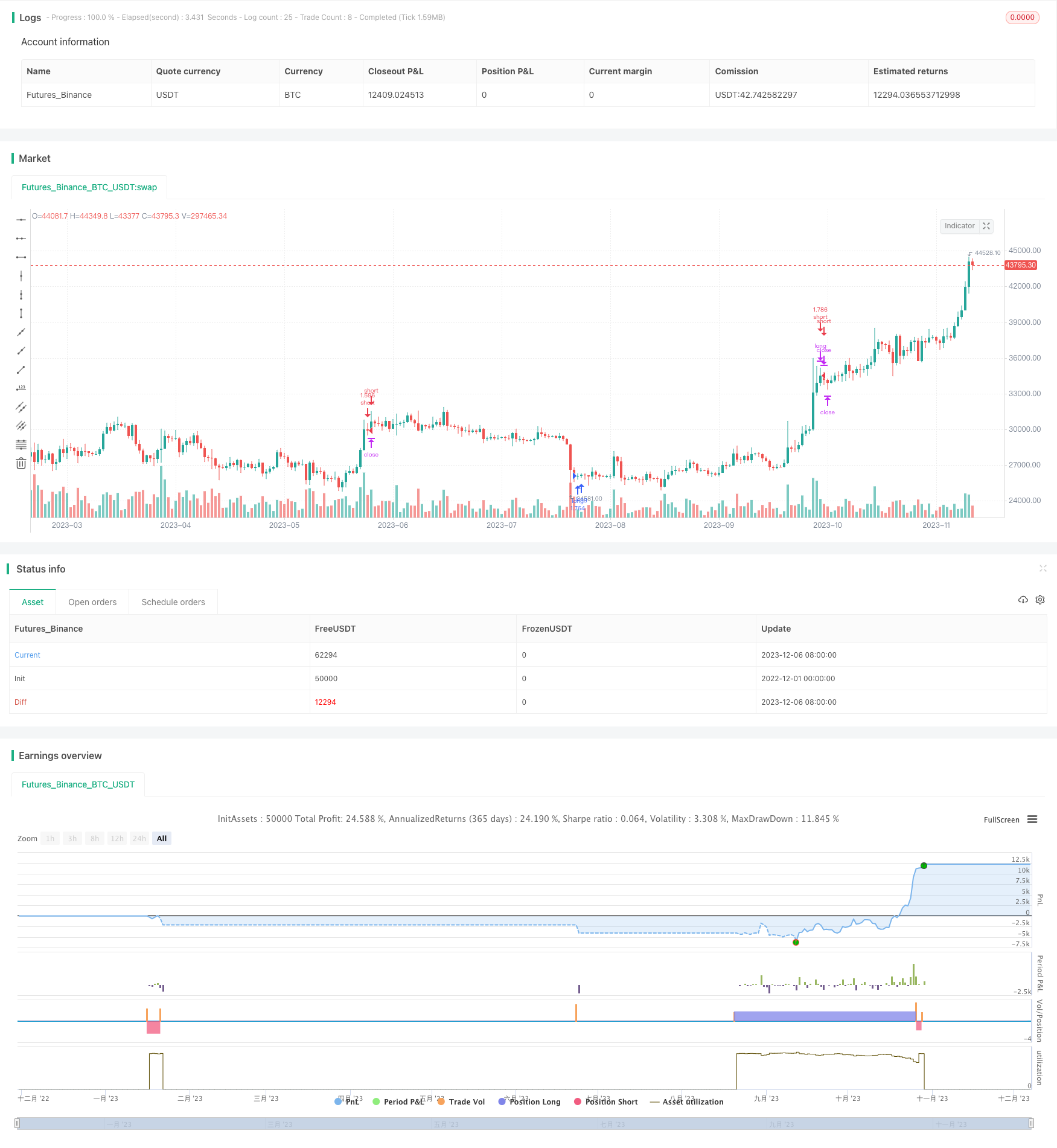
概述
本策略名称为“布林带量化交易策略”,是一种基于改进布林带通道的指数和股票交易策略。该策略通过调整布林带参数,实现对长仓和短仓的同时优化,从而在涨跌市场中都能获利。
策略原理
该策略核心逻辑基于布林带通道。布林带是由中轨、上轨和下轨组成,中轨是n天收盘价的移动平均线,上下轨分别是中轨上下的偏差。当价格接近上轨时,代表市场可能过热,会形成空头机会;当价格接近下轨时,代表市场可能被低估,会形成多头机会。
本策略使用两个布林带,布林带1适用于做多,布林带2适用于做空。布林带1的参数经过优化,长度为25,偏差为2.9倍;布林带2的参数也经过优化,长度为36,偏差为3.2倍。当收盘价上穿布林带1下轨时,会产生做多信号;当收盘价下穿布林带2上轨时,会产生做空信号。
优势分析
相比传统布林带策略,本策略具有以下优势:
实现了多空双边交易。同时适用于两边场景,能抓住市场不同阶段的交易机会。
参数经过优化。两套布林带的参数经过细致测试,能够有效发出交易信号。
风险可控。采用移动止损方式,能够有效控制单边风险。
风险分析
本策略也存在一些潜在风险:
布林带失效风险。当市场出现剧烈波动时,布林带通道可能会失效。
止损被套风险。移动止损可能会被套,从而扩大损失。可以适当宽止损或及时止损来规避。
交易频率过高风险。参数设置过于灵敏,可能会导致频繁交易而增加交易成本。
优化方向
本策略仍有进一步优化的空间:
结合其他指标过滤信号,避免布林带失效时误交易。例如K线形态、成交量等。
动态调整参数,使布林带更贴合不同周期的市场特征。例如采用自适应布林带。
优化止损方式,采用追踪止损或指数移动止损等,有效控制风险。
结合机器学习算法,实现参数的自动优化。
总结
本策略 overall 基于双布林带通道,通过参数优化,实现了对长短双边交易的优化。相比传统布林带策略,具有做多做空、风险控制的优势,适用于捕捉市场不同阶段的机会,具有一定的实战价值。但也存在布林带失效、止损被套等风险,仍需进一步的优化与验证,才能相关产品化。
/*backtest
start: 2022-12-01 00:00:00
end: 2023-12-07 00:00:00
period: 1d
basePeriod: 1h
exchanges: [{"eid":"Futures_Binance","currency":"BTC_USDT"}]
*/
// This source code is subject to the terms of the Mozilla Public License 2.0 at https://mozilla.org/MPL/2.0/
// © exlux99
//@version=4
strategy("BB NDX strategy", overlay = true, default_qty_type = strategy.percent_of_equity, default_qty_value = 100, calc_on_every_tick = true, commission_type = strategy.commission.percent, commission_value = 0.01)
source = close
length = input(25, minval=1, title="Length BB long")
mult = input(2.9, minval=0.001, maxval=50, step=0.1, title="MULT BB long")
length2 = input(36, minval=1, title="Length BB short")
mult2 = input(3.2, minval=0.001, maxval=50, step=0.1, title="MULT BB short")
basis = sma(source, length)
dev = mult * stdev(source, length)
dev2 = mult2 * stdev(source, length2)
upper = basis + dev2
lower = basis - dev
buyEntry = crossover(source, lower)
sellEntry = crossunder(source, upper)
longEntry=input(true)
shortEntry=input(true)
g(v, p) => round(v * (pow(10, p))) / pow(10, p)
risk = input(100)
leverage = input(1.0, step = 0.5)
c = g((strategy.equity * leverage / open) * (risk / 100), 4)
tplong=input(0.065, step=0.005, title="Take profit % for long")
sllong=input(0.04, step=0.005, title="Stop loss % for long")
tpshort=input(0.025, step=0.005, title="Take profit % for short")
slshort=input(0.04, step=0.005, title="Stop loss % for short")
if(longEntry)
strategy.entry("long",1,c,when=buyEntry)
strategy.exit("short_tp/sl", "long", profit=close * tplong / syminfo.mintick, loss=close * sllong / syminfo.mintick, comment='LONG EXIT', alert_message = 'closeshort')
strategy.close("long",when=sellEntry)
if(shortEntry)
strategy.entry("short",0,c,when=sellEntry)
strategy.exit("short_tp/sl", "short", profit=close * tpshort / syminfo.mintick, loss=close * slshort / syminfo.mintick, comment='SHORT EXIT', alert_message = 'closeshort')
strategy.close("short",when=buyEntry)